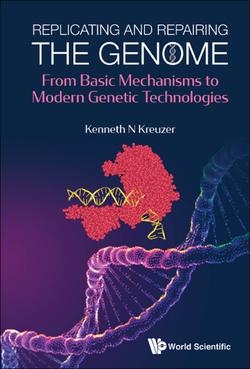Читать книгу Replicating And Repairing The Genome: From Basic Mechanisms To Modern Genetic Technologies - Kenneth N Kreuzer - Страница 17
На сайте Литреса книга снята с продажи.
Chapter 2 The simple DNA replication system of a bacterial virus 2.1Why the interest in a bacterial virus?
ОглавлениеThe DNA replication systems of prokaryotic and eukaryotic cells are quite complex, with over 20 proteins needed to replicate the genome of the model prokaryote Escherichia coli. This complexity undoubtedly relates to the relatively large genome sizes of these cells, the need for a very low error rate particularly given the large genome, the need to replicate the genome once and only once per cell cycle, and the need to carefully couple DNA replication to other cellular events such as cell division.
Because of the complexity of cellular replication systems, many scientists were initially drawn to study DNA replication in simpler viral systems. The rationale was that the key functions in DNA replication would be more evident, the required proteins easier to identify and isolate, and the biochemical mechanisms easier to decipher in a system with fewer interacting parts (i.e., replication proteins). Viruses of bacterial cells, called bacteriophages or phages, provide such simple model replication systems. Some viruses co-opt the host replication machinery, while others encode their own replication proteins. For those viruses that encode their own replication proteins, the number of involved proteins is indeed smaller than for host cell DNA replication.
1969 Nobel Prize in Physiology or Medicine
This prize was awarded to Max Delbruck, Alfred D. Hershey and Salvador E. Luria for their studies on bacterial viruses, elucidating important aspects of their genetic structure and replication mechanisms.
https://www.nobelprize.org/prizes/medicine/1969/summary/
The bacteriophage called T7 turned out to provide a particularly good system for detailed study in that only four proteins are needed to form a fully functional replisome (a few other proteins are involved in initiating and finalizing the process; see below). Studies in this simple T7 system have been very productive, leading to high-resolution structures of each of the replication proteins and the replisome, a complete reconstitution of the reaction with the purified proteins in vitro, and remarkably insightful studies on the dynamics of the replication process based on the in vitro system. These studies of the T7 replication system were spearheaded in the laboratory of Charles C. Richardson (Harvard Medical School). For the same reasons that the T7 system was experimentally tractable, it is also a great system to introduce many of the concepts and mechanisms in DNA replication, and that will be the topic of this chapter.
There is another reason for interest in the T7 replication system. Surprisingly, replication of phage T7 DNA has been found to be very similar to the replication of mitochondrial DNA in human cells. The T7 replication proteins (as well as T7 RNA polymerase) are structurally homologous to the corresponding proteins in human mitochondria, and the basic mechanisms involved in the replication of the two genomes have clear parallels. This has led to the proposal that the genes for mitochondrial replication proteins have their evolutionary origin in a bacterial virus. It is interesting to speculate about how the genes from a bacterial virus could have been captured during the process by which a bacterial cell formed a symbiotic relationship with a primitive eukaryotic cell to form the precursors of mitochondria. Anyone interested in understanding how mitochondria replicate their DNA should certainly start by carefully learning all there is to know about phage T7 DNA replication.
